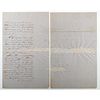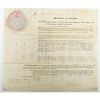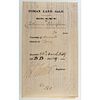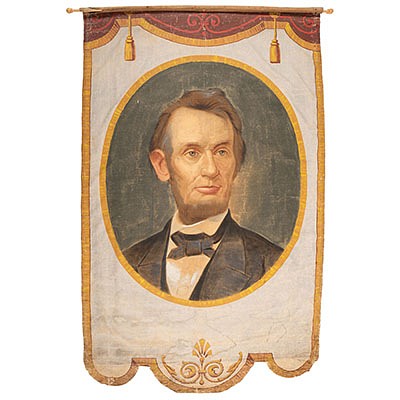[CANADA - FIRST NATIONS]. ARCHIBALD, Adams George (1814-1892). Autograph document signed ("A.G. Archibald") as Lieutenant Governor of Manitoba. Fort G
About Seller
6270 Este Ave.
Cincinnati , OH 45232
United States
With offices in Cincinnati, Cleveland and Denver, Cowan’s holds over 40 auctions each year, with annual sales exceeding $16M. We reach buyers around the globe, and take pride in our reputation for integrity, customer service and great results. A full-service house, Cowan’s Auctions specializes in Am...Read more
Two ways to bid:
- Leave a max absentee bid and the platform will bid on your behalf up to your maximum bid during the live auction.
- Bid live during the auction and your bids will be submitted real-time to the auctioneer.
Bid Increments
| Price | Bid Increment |
|---|---|
| $0 | $25 |
| $500 | $50 |
| $1,000 | $100 |
| $2,000 | $250 |
| $5,000 | $500 |
| $10,000 | $1,000 |
| $20,000 | $2,500 |
| $50,000 | $5,000 |
| $100,000 | $10,000 |
About Auction
Jun 25, 2021
The June 25 American Historical Ephemera and Photography Auction features an exciting assemblage of 18th-early 20th century material, including Civil War archives, Early Photography, Western Americana, Autographs and Manuscripts, and more. Cowan's Auctions dawnie@cowans.com
- Lot Description
Indian land sale grant to Catharine Thompson, vellum, 13.5 x 16 in., for 3/4 of an acre in the Township of Bronte, District of Gore. Purchased for sum of sixteen pounds, fifteen shillings. Recorded 26 March 1849 by R.A. Tucker, Registrar.
Letter to Lac-des-Bois First Nations, 30 March 1871, 3pp., 7.75 x 12.5 in. In French. Contains both a transcription and a translation.
To Chief Ne. Ganik-ishek, to his brother, to Sha-Shaginse, and all the other Indians of Lac-des-Bois.
This letter is written to inform you all the Indians of Lac des Bois that their "Mother", the Queen, does not want the Lac des Bois Indians to come to Fort Garry to attend the Assembly of Red River Indians which is going to take place there. the commissioner who will come on behalf of the Queen wants to see all the Indians on their own lands, and will make separate visits to them.
You have nothing to do with the Red River Lands, and the Indians here have nothing to do with the lands of Lac des Bois.
The Queen expects that all her redskinned subjects from the Lakes area will give all possible help to whites who will travel from Lake Shebandow to Fort Garry, and that they will await patiently the arrival of the Commissioner who is coming from Canada to talk to them, and will discuss with them the subject of passages to cross the lakes.
The Queen says this to you, and expects that all her good subjects, the Lac des Bois Indians, will respect her wishes.
The Canadians, in conjunction with the Queen, in 1871 saw "the necessity of arranging with the bands of Indians inhabiting the tract of country between Thunder Bay and the Stone Fort (Fort Garry), for the cession...of the lands occupied by them. (25)" The government wanted to set aside 160 acres per family of five for the purpose of farming (should they decide to become farmers rather than hunters), but the native peoples preferred larger tracts of land held in common by the tribe. "We told them that whether they wished it or not, immigrants would come in and fill up the country; that every year from this one twice as many in number as their whole people there assembled would pour into the Province, and in a little while would spread all over it, and that now was time for them to come to an arrangement that would secure homes and annuities for themselves and their children (36)." In addition to land, the treaties eventually included clothes, flags, medals, and carriages for most of the chiefs, and annuities for everyone (but at poverty level). "The system of annual payment in money I regard as a good one, because the recipient is enabled to purchase just what he requires when he can get it most cheaply, and it also enables him to buy articles at second hand, from settlers and others, that are quite as useful to hi as are the same things when new. The sum of three dollars does not appear to e large enough to enable an Indian to provide himself with many of his winter necessaries but as he receives the same amount for his wife or wives, and for each of his children, the aggregate sum is usually sufficient to procure many comforts for his family which he would otherwise be compelled to deny himself."
References:
Morris, Alexander. The Treaties of Canada. With the Indians of Manitoba and the North-West Territories. Toronto: Willing & Williamson, 1880. Accessed via Google Books, 28 May 2021.Letter has undergone some repairs (letter from conservator included).Condition
- Shipping Info
-
SHIPPING & PICKUPS Cowan’s Cincinnati Office offers an in-house, full-service shipping department which is unparalleled in the auction industry. Shipping costs are provided with your finalized invoice 24-48 hours after auction. For furniture and oversized items, we recommend using third-party services. For more information, contact cowansshipping@hindmanauctions.com. NOTE: All pickups and preview are by appointment only. To make an appointment, please call 513-871-1670 or email cincinnati@hindmanauctions.com Buyers are required to pay for all packing, shipping and insurance charges. Overseas duty charges are the responsibility of the successful Bidder. Be aware that for larger and/or valuable items, shipping charges can be substantial. - Shipping charges include insurance for your order while in transit. If you have private insurance we will adjust your charge to include only packing and shipping. - Please allow 14 – 21 days after payment to package and ship your purchase as carefully as possible.
-
- Buyer's Premium



 EUR
EUR CAD
CAD AUD
AUD GBP
GBP MXN
MXN HKD
HKD CNY
CNY MYR
MYR SEK
SEK SGD
SGD CHF
CHF THB
THB![[CANADA - FIRST NATIONS]. ARCHIBALD, Adams George (1814-1892). Autograph document signed ("A.G. Archibald") as Lieutenant Governor of Manitoba. Fort G](https://s1.img.bidsquare.com/item/l/8590/8590515.jpeg?t=1LMYtO)
![[CANADA - FIRST NATIONS]. ARCHIBALD, Adams George (1814-1892). Autograph document signed ("A.G. Archibald") as Lieutenant Governor of Manitoba. Fort G](https://s1.img.bidsquare.com/item/s/8590/8590515.jpeg?t=1LMYtO)













